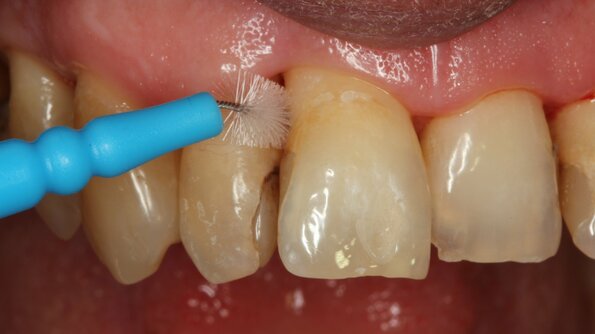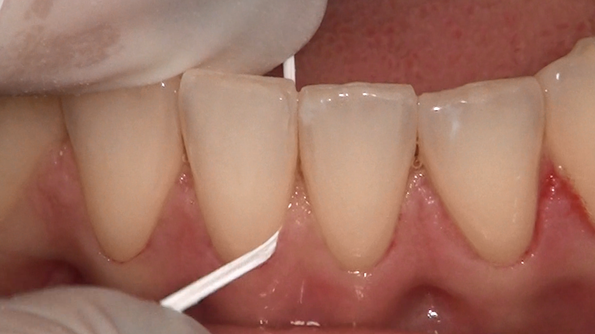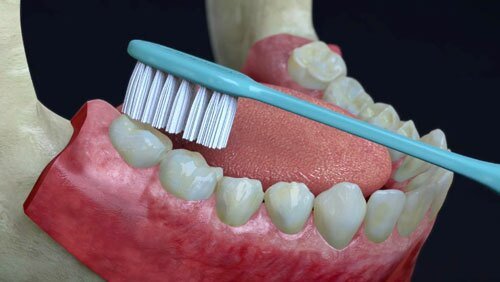Gum disease: Prevention
Preventing gingivitis and periodontitis
Gum diseases – gingivitis and periodontitis – can be prevented by looking after your teeth and gums. This means adopting good habits in oral hygiene and getting regular professional check-ups (at least once a year).
Gum inflammation (gingivitis) will not develop if there is no bacterial plaque on the teeth, and periodontitis will not develop if there is no gingivitis. Continuous good oral hygiene at home, the regular removal of tartar in the dental practice, and addressing risk factors (such as smoking and poor diet) are the key steps to preventing periodontitis.
Oral hygiene at home

The basic elements of good oral hygiene are:
- Brush your teeth at least twice a day, for at least two minutes, using a manual or an electric toothbrush.
- Clean between teeth at least once a day using interdental brushes (also called interproximal brushes) and dental floss if the gaps are too small for brushes. You may need to use differently sized brushes for differently sized gaps. This interdental cleaning should be done before brushing your teeth.


- After brushing your teeth, antiseptic mouthwashes may be used as they can prevent plaque accumulation for up to 12 hours. Chlorhexidine mouthwashes are the most efficient, but have some side effects such as tooth staining, black tongue, change in taste, and they can sometimes erode the mouth’s soft tissues. Chlorhexidine mouthwashes are recommended to be used for a maximum of two weeks. Ask your dentist whether you should use a mouthwash, and which one would be appropriate to your situation.
Special care should be taken to clean thoroughly around crooked or crowded teeth, and around fillings, crowns, and dentures because plaque builds up easily in these places which might be hard to access.
Optimal oral hygiene can therefore vary widely from person to person. It is important to consult your dentist or dental hygienist about which are the best techniques in your case and to ask them for instructions.
There are two main tooth-brushing techniques. The Bass tooth-brushing technique is the most commonly recommended technique, both for people with healthy gums and for those with periodontitis. The Stillman technique is often recommended for patients with gingival recessions.
Video resources
Watch these videos on how to perform tooth cleaning at home:
Dental check-up
In order to prevent both gingivitis and periodontitis, the gums should be examined regularly in the dental practice. Annual check-ups by your dentist are essential and mean that periodontitis can be detected early.
If there are signs of either gingivitis or periodontitis, treatment can be given promptly. If treatment is started early, it can prevent further damage to the structures that hold the teeth in place.
Ask your dentist for a basic periodontal examination as part of your regular dental check-up.
As well as an annual check-up with your dentist, additional appointments for professional cleaning by your dentist, periodontist, or dental hygienist are also important.
The intervals for appointments in this maintenance phase are usually three, four, or six months. The frequency depends on the quality of oral hygiene at home, the extent of gum inflammation, and the presence of what are called residual gum pockets.
Address risk factors
Addressing risk factors can also help prevent the onset of periodontitis. Giving up smoking, avoiding or reducing stress, eating a healthy diet, and exercising can all play a role in supporting good oral hygiene in preventing periodontitis.
Quitting smoking is perhaps the most important measure for preventing gingivitis and periodontitis.
Preventing peri-implant diseases
The key to preventing the appearance of peri-implant diseases (peri-implant mucositis and peri-implantitis) is the same as that for preventing gingivitis and periodontitis: good oral hygiene at home (see above, Oral hygiene at home).
As peri-implantitis is more frequent in patients with a history of periodontitis, these patients should be monitored more thoroughly for any signs of the onset of inflammation and bone loss around implants.
One of the key measures for implant survival is avoiding smoking to prevent the appearance of peri-implant diseases. Annual radiographs of implants are also recommended to detect early bone loss as, in some patients, peri-implantitis can start two to three years after implant placement.
Regular appointments with your dentist of periodontist are essential so that your implants and teeth can be cleaned professionally and any problems can be dealt with promptly before they threaten the stability of your implant and your gum health.
Between these scheduled visits to your dentist or periodontist, it is vital that you make an appointment as soon as possible if you notice any signs of inflammation around your implants.







